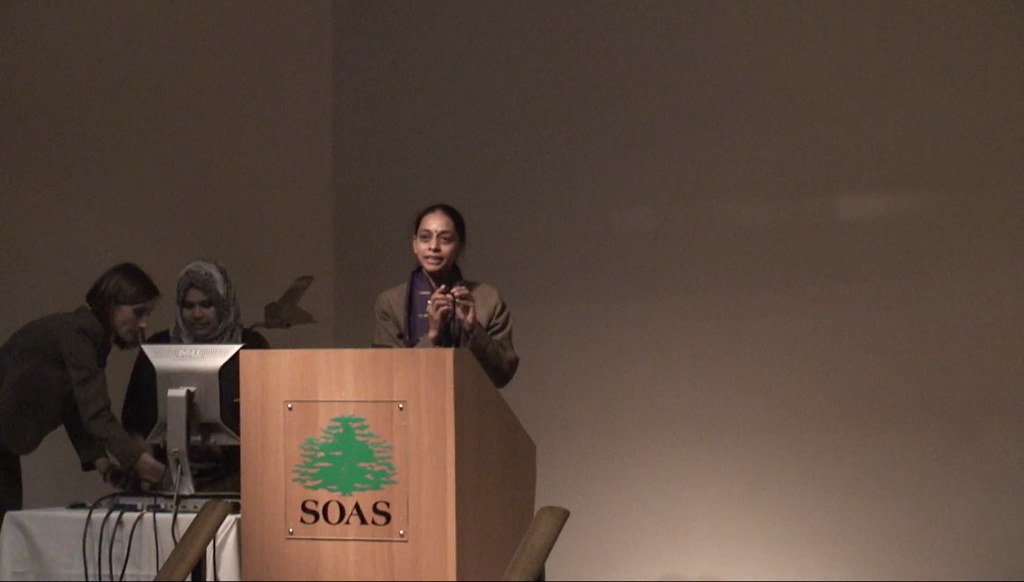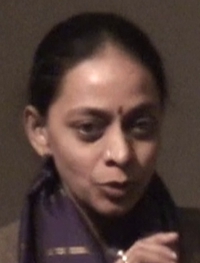
Friday, 7th March 2008
Brunei Gallery Lecture Theater
Jaina Art & Architecture
10th Jaina Studies Workshop at SOAS
 Lecture: "Sites of Identity: Village and Community in Tamil Jaina Stories", R. Uma Maheshwari, JNU, New Delhi
Lecture: "Sites of Identity: Village and Community in Tamil Jaina Stories", R. Uma Maheshwari, JNU, New Delhi
R. Uma Maheshwari, JNU, New Delhi
Sites of Identity: Village and Community in Tamil Jaina Stories
The Tamil Jainas today are categorised as a ‘minority’ community in Tamilnadu - their population being around 30, 000. It has been a long way for a community which has a recorded existence in Tamiḻakam since 2nd and 3rd century BC (going by the earliest records, the Tamil Brāhmi inscriptions) and has contributed extensively to the development and enrichment of Tamil language and literature, with compositions such as Cilappatikāram, Cīvakacintāmaṇi, Nālaṭiyār, Nīlakeci, Naṉṉūl, Tirukkuṟaḷ and Valayāpati.
The Tamil Jaina settlements of today are found mostly in the North and South Arcot, Chengleput, and Tanjavur districts. The majority of Tamil Jainas are agriculturists and the community has been agrarian throughout, as against the general perception of Jainas being only a mercantile community.
The Tamil Jainas are not the later migrant settler Jainas, the Marwari Śvetāmbara Jaina mercantile community (addressed by the Tamil Jainas as ‘seṭh’) settled today in certain pockets of Chennai or other towns in Tamilnadu who may speak Tamil. The Tamil Jainas all follow the Digambara Jaina tradition. Locally they are referred to as ‘naiṉār’.
The Tamil Jaina community is a repository of stories. And stories are one of the means they employ to construct their community identity vis-à-vis the other. These are stories of a community persecuted (there is ample historical evidence to that effect) in history. There is a need to locate the significance - historical and social - of some of these stories, the recurring motifs in these and the metaphors. Recording community narratives / sites of memory, especially of a marginalised minority ‘living’ community assumes historiographical significance, especially when most historical work on the Jainism in Tamilnadu has been around ‘rise’ and ‘decline’ of Jainism constructed from inscriptional records as the sole historical source.
 Lecture: "Sites of Identity: Village and Community in Tamil Jaina Stories", R. Uma Maheshwari, JNU, New Delhi
Lecture: "Sites of Identity: Village and Community in Tamil Jaina Stories", R. Uma Maheshwari, JNU, New Delhi
Tamil Jaina Stories of Persecution and Identity Construction
The story of one “Cakkili rājā”, popularly referred to as the “sumaṉtān talai pattu katai”(one who held ten heads) is up most on the minds of the Tamil Jainas of south Arcot region. A ruler of Gingee / Cenji (Duppala Kistnappa Nayak in local tradition) from a lower caste sought a high caste bride for himself. He went to the brāhmiṇs who told him the Jainas were of a higher caste. He sought a bride from the Jainas. The Jainas, insulted by a low caste ruler seeking a girl from their community, in turn insulted him by tying a dog to the wedding post on the wedding day, and fled the place. He retaliated by ordering severing of heads of Jainas in Cenji country. Fearing their lives, many Jainas converted to the Saiva faith by smearing sacred ash on their foreheads.
They are called the ‘nīr pūci nayiṉārs’ by the Tamil Jainas. According to them these are the present day Śaiva veḷḷāḷar community, who still follow Jaina customs of ‘koḷḷāmai’ (non-killing), avoiding meat and eating before dark. There are other versions with minor variations to this story.
For the Tamil Jainas the ‘other’ were (they distinguished themselves from and felt victimised by) the Śaivas and the brāhmiṇ; and the Śaiva and brāhmiṇ identities at times seem juxtaposed, or an extension of each other. According to them the Śaiva Veḷḷāḷars in fact were a past Jaina community (according to them) that had been victimised into entering the Śaivite religious order.
The persecution stories of different time periods signify the ways in which the Tamil Jainas constructed their identity vis-à-vis the other(s). Be it the brāhmiṇs, or the Śaiva bhakti bards, or the Cakkili rājā of Cenji. Most of these figure in the memory of the community as the ‘mainstream’ / powerful others, who victimised the Tamil Jainas.
Other sites of Identity - Village as Theatre
Village, for the Tamil Jainas, is the ‘theatre’ where history is played out; and in that process gives the community its identity, besides other identities such as caste, language and so forth. There is the local, regional Jaina (Tamil) history that they see themselves as part of rather than one monolithic pan-Jaina, pan-Indian Jaina history. Their place in history is vectored through the history of their village; the association of their village vectored through history of their religion; their village in the history of Tamil Jaina religion, its place there. Each village has its own importance within a circulatory space - sacred and secular; antiquity of the village and its link with religion is something everybody stresses on.
 Lecture: "Sites of Identity: Village and Community in Tamil Jaina Stories", R. Uma Maheshwari, JNU, New Delhi
Lecture: "Sites of Identity: Village and Community in Tamil Jaina Stories", R. Uma Maheshwari, JNU, New Delhi
The Cakkili Rājā Story and its Motifs
There is, for one, the lower caste angle to the ‘Cakkili rājā’, which may explain the nature of response to his proposal seeking a marriage alliance - tying a dog to a post and leaving a note on its collar - and also explains the nature of punishments he is said to have meted on the community (beheading the Jainas). But there may be other angles to the story. Thurston records Venkatapati Nayaka (alias Kistnappa Nayaka)’s time to be 1478. “By late 14th century, northern Tamilnadu was organised into five or six provinces called rājya or ucāvadi...; this administrative system...was highly exploitative and colluded with local military leaders (nāyaka) and landlords (kaṇiyāḷar) in extorting as much revenue as possible....” And in 1429, a “revolt of cultivators and artisans” also seems to have taken place. In this context, could we conjecture that these nāyakas (and their chiefs) might possibly have been aided and assisted by certain castes in this exercise? In which case, the Tamil Jainas (agriculturists) fled and their land was usurped by brāhmiṇs and Śaiva veḷḷāḷars - the latter being in a larger majority today in some of the areas. The community of Manjaputhur Chettiars also narrates a community origin story similar to that of the Tamil Jainas. They are Śaiva veḷḷāḷars. They worship a deity that resembles a tīrthankara image. In some places in Tamilnadu, any case, the Jainas do have the caste suffix of Cheṭṭi. Something serious had to have happened which gave rise to this story - a story that is part of the collective memory of the Tamil Jainas of the South Arcot region. All those who feared for their lives converted to Śaivism (and not any other religious sect) adorning the sacred ash, ‘throwing away their sacred threads’. They assume the identity of Śaiva (nīr pūci) veḷḷāḷars or nīr pūci nayiṉārs (the Jainas who smeared sacred ash). Did the story indeed originate among the Tamil Jainas of South Arcot? Or was it a Śaivite revivalist story meant to show the weakness and fear of a community, which turned into Śaiva ‘nayiṉārs’ to save their lives? Or of a successful ‘vanquishing’ of the Jaina community from the region?
One is also looking at ‘persecution’ from outside the purview of a religious (‘communal’) conflict alone, to re-visit the nature of intra-veḷḷāḷar conflict between the Śaiva and Jaina veḷḷāḷars. By the post-bhakti period the Jainas seem to have a relatively greater hold over south Arcot and surrounding areas rather than Madurai and Kancipuram of the early periods. Where they forced to migrate to the former region at some point?
The history of the Tamil Jaina community does not remain a static one that can be explained against the dominance of the bhakti, agrarian expansion of that period, royal patronage and decline within a period of 7th to 9th centuries AD. It continues through other periods, beyond the bhakti paradigm, constantly seeking to refresh the identity question. But most certainly the bhakti period persecution sets the ‘base’ for marginalisation of the community which never quite manages to get back to a status it aimed for, in the early centuries BC, and AD.
One does not come across sociological or historically contextualised studies around these community stories of the Tamil Jainas. If this story is so strongly remembered regarding their community, did it historically take place? Even at the metaphorical level, it is intriguing that this story does not have any mention in the works on Jainism in Tamilnadu, even as a ‘wandering tale’ that the Jainas remember, recount (and in that sense, re-live). One is trying to locate the story within the question of the Tamil Jaina identity under threat, and their perception of the other community closest to them in attitudes and perceptions on certain everyday habits, the ‘nīr-pūci’ Śaiva veḷḷāḷars. Or perhaps this story has more to it than the persecution of Jainas?
That Cenji region and South Arcot seem to have numerous stories - there is the Muṭṭāl Rāvuttan story, the Desingu raja story, Draupadi stories, the above-mentioned cakkili rājā story, the Nīli-Nilakeci stories, etc. Cenji - south Arcot seems to abound in story telling traditions. All these stories have their own perspective on the region. A comparative analysis of the stories may in course of time lead to new information on this region, or the Tamil Jainas, that may be missed if inscriptional records are taken at their face value, as the sole sources of reconstructing their history.
There are stories (one would cite examples) which reflect efforts at land appropriation and seeking control over the sources of cultivation. The reasons for conflict and contestation come from the political and economic concerns as well - land, power, in turn intrinsically linked to ideology and religious systems. The reasons have to be seen not merely in religious antagonism but in the larger ownership and control of resources, manifesting only partially in the nature of religious antagonism and conflict. While initially Jaina and Buddhist religious establishments contested for support from ruling classes (and the laity) it shifted to Jaina-Śaiva (and to a limited extent Vaiṣṇava) - brāhmiṇical conflict.
The stories - like the cakkili rājā story - only give a ‘starting point’ of a different nature, to locate the Tamil Jainas’ own construction of their identity as Jaina veḷḷāḷars. And as Jainas.
10 minutes on video:
Full SpeechAudio:
|
 Dr. R. Uma Maheshwari
Dr. R. Uma Maheshwari